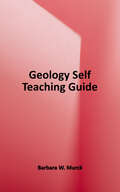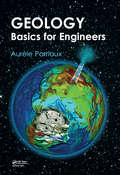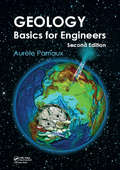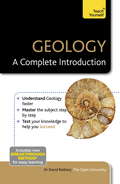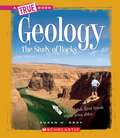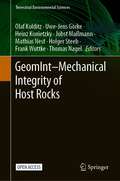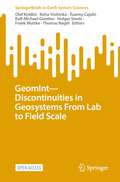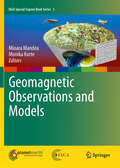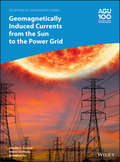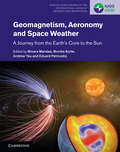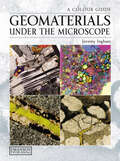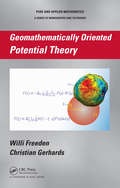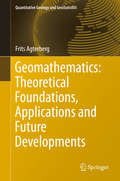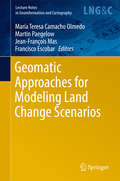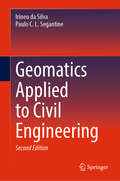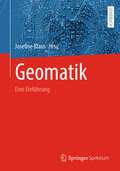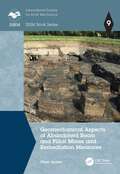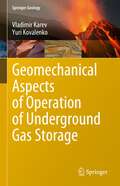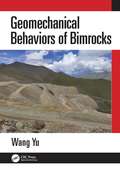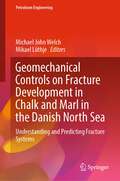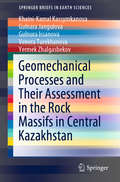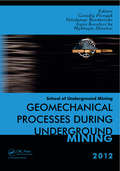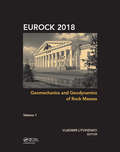- Table View
- List View
Geology: A Self-teaching Guide
by Barbara MurckTake a learning journey through billions of years of Earthhistory This indispensable guide to the fundamentals of geology is theideal way to introduce yourself to all the basics, from rocks,minerals, and fossil fuels to earthquakes, volcanoes, and platetectonics. Using quick quizzes and self-tests to reinforce keyconcepts, Geology carefully walks you through billions of years ofEarth history. Illustrated with more than one hundred speciallycommissioned illustrations and fifty photographs that help clarifydifficult concepts, this easy-to-follow book is an interactiveresource for anyone interested in learning more about ourplanet. Whether you are new to geology or want to refresh and update yourknowledge, the proven self-teaching guide approach will allow youto work at your own pace, check your progress, and learn more aboutthis fascinating field of study.
Geology: Basics for Engineers
by Aurele ParriauxGeology – Basics for Engineers presents the physical and chemical characteristics of the Earth, the nature and the properties of rocks and unconsolidated deposits/sediments, the action of water, how the earth is transformed by various phenomena at different scales of time and space. The book shows the engineer how to take geological conditions into account in his projects, and how to exploit a wide range of natural resources in an intelligent way, reduce geological hazards, and manage subsurface pollution.Through a problem-based-learning approach, this instructional text imparts knowledge and practical experience to engineering students (undergraduate and graduate level), as well as to experts in the fields of civil engineering, environmental engineering, earth sciences, architecture, land and urban planning. The DVD that supplements the book contains solutions to the problems and animations that show additional facets of the living Earth. *The original French edition of the book (2007) won the prestigious Roberval Prize, an international contest organized by the University of Technology of Compiegne in collaboration with the General Council of Oise, France. Geology, Basics for Engineers, was selected out of a total of 110 candidates.The jury praised the book as a “very well conceived teaching textbook” and underscored its highly didactic nature, as well as the excellent quality of its illustrations.
Geology: Basics for Engineers, Second Edition
by Aurèle ParriauxGeology – Basics for Engineers (second edition) presents the physical and chemical characteristics of the Earth, the nature and the properties of rocks and unconsolidated deposits/sediments, the action of water, how the Earth is transformed by various phenomena at different scales of time and space. The book shows the engineer how to take geological conditions into account in their projects, and how to exploit a wide range of natural resources in an intelligent way, reduce geological hazards, and manage subsurface pollution. This second edition has been fully revised and updated. Through a problem-based learning approach, this instructional text imparts knowledge and practical experience to engineering students (undergraduate and graduate level), as well as to experts in the fields of civil engineering, environmental engineering, earth sciences, architecture, land and urban planning. Free digital supplements to the book, found on the book page, contain solutions to the problems and animations that show additional facets of the living Earth. The original French edition of the book (2007) won the prestigious Roberval Prize, an international contest organized by the University of Technology of Compiegne in collaboration with the General Council of Oise, France. Geology, Basics for Engineers was selected out of a total of 110 candidates. The jury praised the book as a "very well conceived teaching textbook" and underscored its highly didactic nature, as well as the excellent quality of its illustrations.
Geology: Teach Yourself
by David RotheryWritten by David Rothery, who is Professor of Planetary Geosciences at the Open University, Geology: A Complete Introduction is designed to give you everything you need to succeed, all in one place. It covers the key areas that students are expected to be confident in, outlining the basics in clear English, and then providing added-value features like a glossary of the essential jargon terms, links to useful websites, and even examples of questions you might be asked in a seminar or exam. The book uses a structure chosen to cover the essentials of most school and university courses on Geology. Topics covered include the Earth's structure, earthquakes, plate tectonics, volcanoes, igneous intrusions, metamorphism, weathering, erosion, deposition, deformation, physical resources, past life and fossils, the history of the Earth, Solar System geology, and geological fieldwork. There are useful appendices of minerals, rock names and geological time.
Geology: The Study Of Rocks
by Susan Heinrichs GrayWhether you're interested in weather, oceans, or even the prehistoric world, earth science covers it all. The fascinating facts and fun activities in these titles help the budding earth scientist in you explore the fields of geology, meteorology, ecology, and more.
GeomInt–Mechanical Integrity of Host Rocks (Terrestrial Environmental Sciences)
by Thomas Nagel Uwe-Jens Görke Olaf Kolditz Frank Wuttke Heinz Konietzky Jobst Maßmann Mathias Nest Holger SteebThis open access book summarizes the results of the collaborative project “GeomInt: Geomechanical integrity of host and barrier rocks - experiment, modeling and analysis of discontinuities” within the Program: Geo Research for Sustainability (GEO: N) of the Federal Ministry of Education and Research (BMBF). The use of geosystems as a source of resources, a storage space, for installing underground municipal or traffic infrastructure has become much more intensive and diverse in recent years. Increasing utilization of the geological environment requires careful analyses of the rock–fluid systems as well as assessments of the feasibility, efficiency and environmental impacts of the technologies under consideration. The establishment of safe, economic and ecological operation of underground geosystems requires a comprehensive understanding of the physical, (geo)chemical and microbiological processes on all relevant time and length scales. This understanding can only be deepened on the basis of intensive laboratory and in-situ experiments in conjunction with reliable studies on the modeling and simulation (numerical experiments) of the corresponding multi-physical/chemical processes. The present work provides a unique handbook for experimentalists, modelers, analysts and even decision makers concerning the characterization of various types of host rocks (salt, clay, crystalline formations) for various geotechnical applications.
GeomInt—Discontinuities in Geosystems From Lab to Field Scale (SpringerBriefs in Earth System Sciences)
by Thomas Nagel Olaf Kolditz Frank Wuttke Holger Steeb Keita Yoshioka Tuanny Cajuhi Ralf-Michael GüntherThis is an open access book. In view of growing conflicts over strategic georesources, the use of the geological subsurface in the sense of a regional resource is becoming increasingly important. In this context, georeservoirs are playing an important role for the energy transition not only as a source of energy but also as a storage facility and deep geological disposal for energy waste. The success of the energy transition also depends to a large extent on the efficient and safe use of underground resources.This book complements the previous basic book (GeomInt—Integrity of Host Rocks) with a series of application examples in different rock formations, clay, salt, and crystalline. The methodology developed in GeomInt is used, among others, in the Mont Terri underground research laboratory (Opalinus Clay), in the large borehole test in Springen (salt rock) and in the “Reiche Zeche” teaching and research mine (crystalline rock). In addition, new methodological developments are also taken up in experiments and models and embedded in workflows for geotechnical system analyses. The present book summarizes the results of the collaborative project “GeomInt2: Geomechanical integrity of host and barrier rocks - experiment, modeling and analysis of discontinuities” within the program: Geo Research for Sustainability (GEO: N) of the Federal Ministry of Education and Research (BMBF).
Geomagnetic Observations and Models
by M. Mandea Monika KorteThis volume provides comprehensive and authoritative coverage of all the main areas linked to geomagnetic field observation, from instrumentation to methodology, on ground or near-Earth. Efforts are also focused on a 21st century e-Science approach to open access to all geomagnetic data, but also to the data preservation, data discovery, data rescue, and capacity building. Finally, modeling magnetic fields with different internal origins, with their variation in space and time, is an attempt to draw together into one place the traditional work in producing models as IGRF or describing the magnetic anomalies.
Geomagnetically Induced Currents from the Sun to the Power Grid (Geophysical Monograph Series #246)
by Jennifer L. Gannon Andrei Swidinsky Zhonghua XuAn introduction to geomagnetic storms and the hazards they pose at the Earth’s surface Geomagnetic storms are a type of space weather event that can create Geomagnetically Induced Currents (GICs) which, once they reach Earth’s surface, can interfere with power grids and transport infrastructure. Understanding the characteristics and impacts of GICs requires scientific insights from solar physics, magnetospheric physics, aeronomy, and ionospheric physics, as well as geophysics and power engineering. Geomagnetically Induced Currents from the Sun to the Power Grid is a practical introduction for researchers and practitioners that provides tools and techniques from across these disciplines. Volume highlights include: Analysis of causes of geomagnetic storms that create GICs Data and methods used to analyze and forecast GIC hazard GIC impacts on the infrastructure of the bulk power system Analysis techniques used in different areas of GIC research New methods to validate and predict GICs in transmission systems
Geomagnetism, Aeronomy and Space Weather: A Journey from the Earth's Core to the Sun (Special Publications of the International Union of Geodesy and Geophysics #4)
by Monika Korte Eduard Petrovský Mioara Mandea Andrew YauOn the centenary of the International Union of Geodesy and Geophysics, this book reviews the state-of-the-art research in geomagnetism, aeronomy and space weather. Written by eminent researchers from these fields, it summarises the advances in research over the past 100 years, and looks ahead to current and emerging studies on Earth's magnetic field. It provides a comprehensive overview of the generation of Earth's magnetic field, its history and its response to external forces. Starting at the centre of the Earth, the reader is taken on a journey from the interior core and mantle, through the upper atmosphere and magnetosphere, before reaching the Sun's atmosphere and corona. The applications of this research are also discussed, particularly the societal impact of solar activity on critical infrastructures in our increasingly technologically dependant society. This book provides a valuable resource and reference to academic researchers and students in geomagnetism and aeronomy.
Geomaterials Under the Microscope: A Colour Guide
by Jeremy InghamThe first comprehensive guide to the petrography of geomaterials, making the petrographers specialist knowledge available to practitioners, educators and students worldwide interested in modern and historic construction materials.
Geomathematically Oriented Potential Theory (Chapman & Hall/CRC Pure and Applied Mathematics)
by Willi Freeden Christian GerhardsAs the Earth`s surface deviates from its spherical shape by less than 0.4 percent of its radius and today's satellite missions collect their gravitational and magnetic data on nearly spherical orbits, sphere-oriented mathematical methods and tools play important roles in studying the Earth's gravitational and magnetic field. Geomathematically Orien
Geomathematics: Modelling and Solving Mathematical Problems in Geodesy and Geophysics
by Volker MichelGeomathematics provides a comprehensive summary of the mathematical principles behind key topics in geophysics and geodesy, covering the foundations of gravimetry, geomagnetics and seismology. Theorems and their proofs explain why physical realities in geoscience are the logical mathematical consequences of basic laws. The book also derives and analyzes the theory and numerical aspects of established systems of basis functions; and presents an algorithm for combining different types of trial functions. Topics cover inverse problems and their regularization, the Laplace/Poisson equation, boundary-value problems, foundations of potential theory, the Poisson integral formula, spherical harmonics, Legendre polynomials and functions, radial basis functions, the Biot-Savart law, decomposition theorems (orthogonal, Helmholtz, and Mie), basics of continuum mechanics, conservation laws, modelling of seismic waves, the Cauchy-Navier equation, seismic rays, and travel-time tomography. Each chapter ends with review questions, with solutions for instructors available online, providing a valuable reference for graduate students and researchers.
Geomathematics: Theoretical Foundations, Applications and Future Developments
by Frits AgterbergThis book provides a wealth of geomathematical case history studies performed by the author during his career at the Ministry of Natural Resources Canada, Geological Survey of Canada (NRCan-GSC). Several of the techniques newly developed by the author and colleagues that are described in this book have become widely adopted, not only for further research by geomathematical colleagues, but by government organizations and industry worldwide. These include Weights-of-Evidence modelling, mineral resource estimation technology, trend surface analysis, automatic stratigraphic correlation and nonlinear geochemical exploration methods. The author has developed maximum likelihood methodology and spline-fitting techniques for the construction of the international numerical geologic timescale. He has introduced the application of new theory of fractals and multi fractals in the geostatistical evaluation of regional mineral resources and ore reserves and to study the spatial distribution of metals in rocks. The book also contains sections deemed important by the author but that have not been widely adopted because they require further research. These include the geometry of preferred orientations of contours and edge effects on maps, time series analysis of Quaternary retreating ice sheet related sedimentary data, estimation of first and last appearances of fossil taxa from frequency distributions of their observed first and last occurrences, tectonic reactivation along pre-existing schistosity planes in fold belts, use of the grouped jackknife method for bias reduction in geometrical extrapolations and new applications of the theory of permanent, volume-independent frequency distributions.
Geomatic Approaches for Modeling Land Change Scenarios
by Francisco Escobar María Teresa Camacho Olmedo Martin Paegelow Jean-François MasThis book provides a detailed overview of the concepts, techniques, applications, and methodological approaches involved in land use and cover change (LUCC) modeling, also known simply as land change modeling. More than 40 international experts in this field have participated in this book, which illustrates recent advances in LUCC modeling with examples from North and South America, the Middle East, and Europe. Given the broad range of geomatic approaches available, it helps readers select the approach that best meets their needs. The book is structured into five parts preceded by a foreword written by Roger White and a general introduction. Part I consists of four chapters, each of which focuses on a specific stage in the modeling process: calibration, simulation, validation, and scenarios. It presents and explains the fundamental ideas and concepts underlying LUCC modeling. This is complemented by a comparative analysis of the selected software packages, practically applied in various case studies in Part II and Part III. Part II discusses recently proposed methodological developments that have enhanced modeling procedures and results while Part III offers case studies as well as interesting, innovative methodological proposals. Part IV revises different fundamental techniques used in LUCC modeling and finally Part V describes the best-known software packages used in the applications presented in Parts II and III.
Geomatics Applied to Civil Engineering
by Irineu da Silva Paulo C. SegantineThis textbook deals jointly with theoretical and practical concepts within geomatics in civil engineering, based on the global understanding of its use. Written by civil engineers with professional backgrounds in geomatics, the book has a number of unique characteristics, including analysis of geodetic references and their coordinate systems to allow their conversions and applications taking into account the local topographic plan; analysis of the measurements of directions, angles and distances, inserting them into the concepts of practical use of modern measuring instruments; detailed description of the main components of measurement instruments used in geomatics; discussion of instrumentation errors and their implications; and a complete study of UTM Projection System and its variants, equations, and practical application in civil engineering projects. For students and instructors, and practitioners, the subjects covered in the book are organized to cover most topics related to the disciplines of surveying or geomatics studied in civil engineering courses. It is entirely based on adjustment computation for spatial data analysis including coordinate geometry and traverse computation. To this end, an entire chapter is devoted to adjustment computation based on matrix theory to help readers understand its applications in spatial data analysis throughout the book’s chapters; including chapters on modern technologies such as conventional and UAV-based digital photogrammetry, digital terrain modelling, terrestrial laser scanning and BIM.
Geomatik: Eine Einführung
by Josefine KlausWas ist eine Mercatorabbildung? Wie berechnet man Koordinaten? Wie funktioniert ein Geoinformationssystem? Diese und viele weitere Fragen beantwortet „Geomatik - Eine Einführung“ und bietet damit zum ersten Mal die theoretischen Grundlagen der Ausbildung zur/zum Geomatiker:in in einem Werk.Folgende Themen werden auf der Grundlage des bundesweit einheitlichen Rahmenlehrplans der Berufsausbildung behandelt:Organisation des Vermessungswesen Erfassung, Bearbeitung und Präsentation von Geodaten Verwaltung von GeodatenGrundlagen des Web- und Printdesigns Selbstständige Entwicklung von GeoproduktenDie Inhalte werden ergänzt durch ein auf die Prüfungen angepasstes Lernangebot und zahlreiche weiterführende Informationsquellen. Dadurch entsteht ein umfassendes und zeitgemäßes Handbuch für den Berufsschulunterricht und zur Prüfungsvorbereitung im Bereich der Geoinformatik, Vermessung und Kartographie. Aus einer modernen, digitalen Wissensvermittlung sind die visuellen und kartenbasierten Ansätze der Geomatik nicht mehr wegzudenken. Die in diesem Buch angebotenen Informationen ermöglichen es angehenden Geomatiker:innen und Interessierten selbstständig eigene Geoprodukte zu erstellen.
Geomechanical Aspects of Abandoned Room and Pillar Mines and Remediation Measures (ISRM Book Series)
by Ömer AydanGeomechanical Aspects of Abandoned Room and Pillar Mines and Remediation Measures addresses the occurrence, prediction, and control of subsidence issues encountered in room and pillar mining, including creep, degradation, and seismic aspects. The book distinguishes itself by: Presenting a unified treatise on room and pillar mines Using clear definitions and explanations of fundamental concepts Considering long-term aspects (creep and degradation), seismic effects, remedial measures, contact types, and remote sensing monitoring techniques Including physical and numerical modeling Demonstrating an in-depth view of procedures and solution techniques This book provides a clear understanding of active and/or abandoned room and pillar mines. It is aimed at academics and engineers with a mining and/or civil engineering background, but it also serves as a reference for undergraduate and graduate students.
Geomechanical Aspects of Operation of Underground Gas Storage (Springer Geology)
by Vladimir Karev Yuri KovalenkoThis book is devoted to the most important and urgent problems arising during the operation of underground gas storage facilities (UGS) and associated with the destruction of the reservoir and sand production into the wells. UGS facilities play a special role in ensuring high reliability of stable and guaranteed gas supplies to consumers. However, despite many years of experience in UGS well operation, there is still no sufficiently substantiated geomechanical model of reservoir failure and a mathematical description of the processes occurring in the reservoir-well system, taking into account the peculiarities of the mechanical behavior of reservoir rocks during cyclic injection and extraction of gas. As a result, there are no reliable criteria for establishing a rational regime for the operation of an UGS wells in conditions of a possible destruction of reservoir rocks. Further development of underground gas storage direction requires the introduction of innovative technologies that can be used both in the design of new UGS facilities and to extend the safe and efficient operation of existing underground gas storage facilities. To solve these problems, the most promising technologies, taking into account their efficiency, relatively low cost and environmental safety, are those based on the geomechanical approach.The book is addressed to specialists in the development and operation of underground gas storage facilities, as well as specialists in geomechanics of oil and gas fields. It can be useful for students and graduate students studying in the speciality "Development of oil and gas fields".
Geomechanical Behaviors of Bimrocks
by Wang YuThis book is intended as a reference book for advanced graduate students and research engineers in block-in-matrix rocks (bimrocks) or soil and rock mixtures (SRMs) or rock and soil aggregate (RSA). Bimrocks are complex formations characterized by competent rock inclusions floating in a weaker matrix. Typical types of bimrocks include a series of mixed geological or engineering masses such as mélanges, fault rocks, coarse pyroclastic rocks, breccias, sheared serpentines, and waste dump mixture. Bimrock is especially different from the general soil and rock material, and the detection of the damage and fracture is still wide open to innovative research. Globally, there is a widespread interest in investigating the geomechanical behaviors of bimrocks, such as deformation and strength characteristics, damage and fracture evolution, and stability prediction of bimrock construction. However, the meso-structural factors control the whole mechanical properties of bimrocks; the source of the macroscopic deformation phenomenon is the meso-structural changes. Therefore, evaluation of the mesoscopic physical and mechanical properties, together with advanced testing technique, is an attractive research topic in rock mechanics. As a result, comprehensive macroscopic and mesoscopic experimental investigations should be conducted to reveal the damage and fracturing mechanical behaviors of bimrocks. The readers of this work can gain new insights into the meso-structural changes of bimrocks subjected to different stress paths. This book is expected to improve the understanding of the mesoscopic damage and fracturing mechanisms of bimrocks, and can be helpful to predict the stability of rock structures where rock mass is subjected to complex loading conditions.
Geomechanical Controls on Fracture Development in Chalk and Marl in the Danish North Sea: Understanding and Predicting Fracture Systems (Petroleum Engineering)
by Michael John Welch Mikael LüthjeThis book summarizes new discoveries on fracturing in chalk. Based on studies on the Danish North Sea, this book shows how observations from outcrop analogues, core and seismic data can be used to characterize the density, distribution and geometry of natural fractures in chalk and marl. Laboratory experiments on chalk samples reveal the controls on the geomechanical properties of chalk and thus on the growth of natural fractures. Finally, various modeling techniques are employed to investigate the mechanical deformation in the chalk structures of the Danish North Sea and to predict fracture distribution and geometry in the subsurface. An understanding of fracture density, distribution and geometry is essential for planning efficient fluid extraction or injection strategies and CO2 sequestration. This book provides the necessary knowledge.
Geomechanical Processes and Their Assessment in the Rock Massifs in Central Kazakhstan (SpringerBriefs in Earth Sciences)
by Gulnura Issanova Khaini-Kamal Kassymkanova Gulnara Jangulova Venera Turekhanova Yermek ZhalgasbekovThis book focuses on the mineral deposits from the mining complex of Kazakhstan, including copper ores from the Nikolayevsky and Shemonaikhinsky open-pit quarries, and from the Kazchrome and Konyrat mines in Balkhash. This study assesses the geomechanical conditions of the rock massive, as well as strengthening and reinforcing processes. It develops methods for their assessment and provides detailed instructions on applying the methods. The book also summarizes the latest research and developments in formulating cement solutions to reinforce slopes and suppress dust on the roads of the quarry. The book’s overarching goal is to promote geological and mining engineering conditions that ensure the ecologically safe development of the mineral resource fields. Given its scope, the book will be of interest to mining engineers, researchers, and students in a broad range of geomechanical, geodesic, mining and environmental fields.
Geomechanical Processes during Underground Mining: School of Underground Mining 2012
by Genadiy Pivnyak Volodymyr Bondarenko Iryna Kovalevs'Ka Mykhaylo IlliashovThis volume deals with economic aspects of mining companies development strategies, various mineral deposits development techniques, imitational modeling of mine workings with rock massif, methane extraction technologies during coal mining, geomechanical processes during plow mining, mining transport importance for mineral extraction, massif
Geomechanics and Geodynamics of Rock Masses, Volume 1: Proceedings of the 2018 European Rock Mechanics Symposium
by Vladimir LitvinenkoThis book is Volume 1 of the EUROCK 2018 proceedings. Geomechanics and Geodynamics of Rock Masses contains contributions presented at EUROCK 2018, the 2018 International Symposium of the International Society for Rock Mechanics (ISRM 2018, Saint Petersburg, Russia, 22-26 May 2018). Dedicated to recent advances and achievements in the fields of geomechanics and geotechnology, the main topics of the book include:- Physical and mechanical properties of fractured rock (laboratory testing and rock properties, field measurements and site investigations)- Geophysics in rock mechanics- Rock mass strength and failure- Nonlinear problems in rock mechanics- Effect of joint water on the behavior of rock foundation- Numerical modeling and back analysis- Mineral resources development: methods and rock mechanics problems- Rock mechanics and underground construction in mining, hydropower industry and civil engineering- Rock mechanics in petroleum engineering- Geodynamics and monitoring of rock mass behavior- Risks and hazards- Geomechanics of technogenic depositsGeomechanics and Geodynamics of Rock Masses will be of interest to researchers and professionals involved in the various branches of rock mechanics and rock engineering. EUROCK 2018, organized by the Saint Petersburg Mining University, is a continuation of the successful series of ISRM symposia in Europe, which began in 1992 in Chester, UK.
